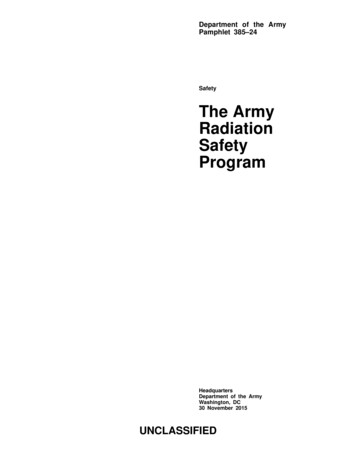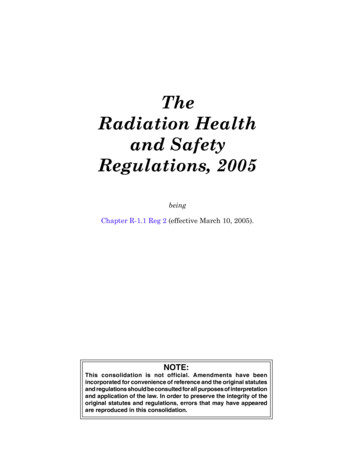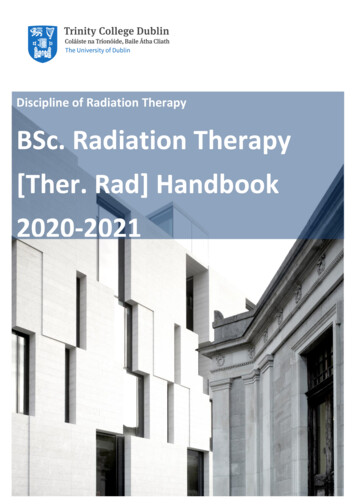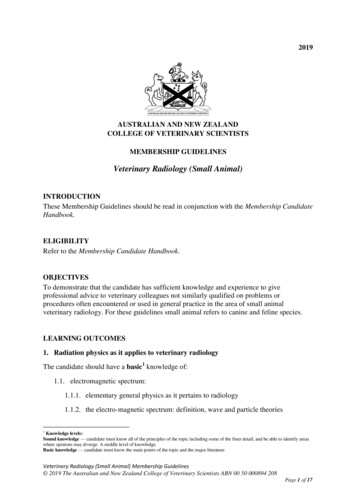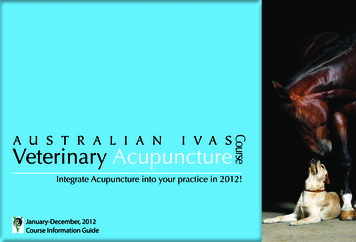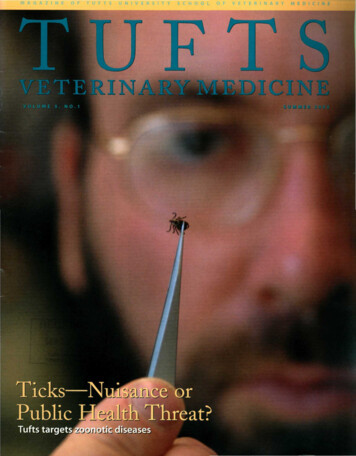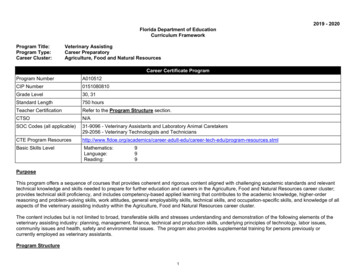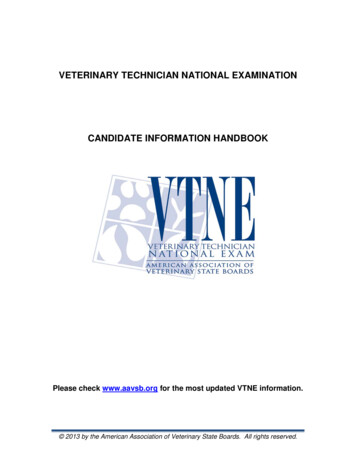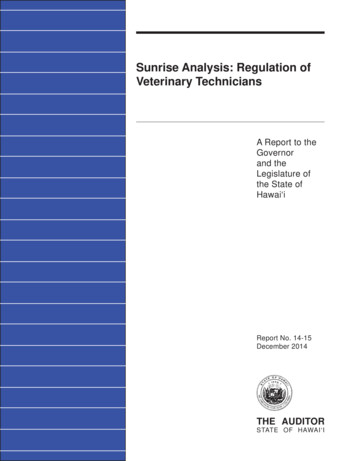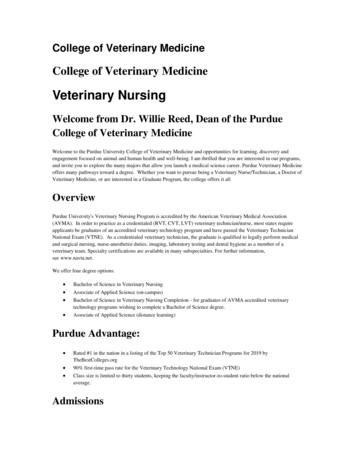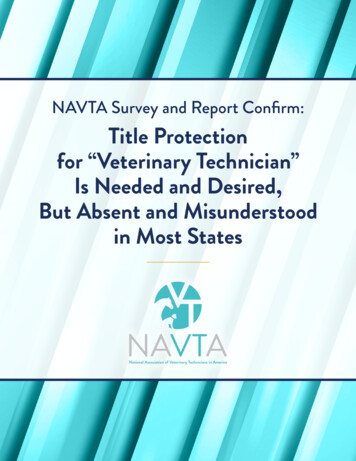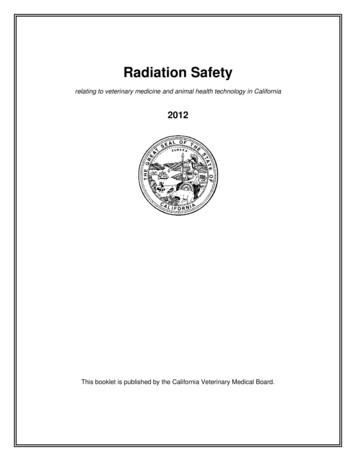
Transcription
Radiation Safetyrelating to veterinary medicine and animal health technology in California2012This booklet is published by the California Veterinary Medical Board.
Table of ContentsSection 1: Effects of Radiation to the Body3Section 2: Competency and Training of the Veterinary Radiographer6Section 3: Personnel Monitoring7Section 4: Occupational Dose Equivalent Limits8Section 5: Veterinary Radiographic Machine Requirements9Section 6: Veterinary Radiographer Protective Apparel12Section 7: Veterinary Radiographer Responsibilities13Section 8: Darkroom Quality Assurance Requirements16Section 9: Manual Film Developing17Section 10: Employing/Supervisor Veterinarian Responsibilities19Section 11: Review Questions21Section 12: Resources and Regulations23General DefinitionsSection 13: Radiation Safety Examination for Unregistered Assistants2530
Section 1:Effects of Radiation to the BodyRadiation injures tissue by ionizing molecules within body cells, that is, depositing energy andcausing an electron or electrons to be removed from an atom of the molecule. These ionizedmolecules may be inactivated and cell death may result. There is a greater variation in theresponse of different tissues to radiation. The cells most sensitive to radiation are those whichdivide the most actively-examples include: epithelium, hematopoietic cells, cells lining the smallintestine, and reproductive cells. The fetus is particularly sensitive to radiation. Cells moreresistant to the effects of radiation include those cells which do not actively divide such as nerveand muscle cells.Ionizing radiation can cause both somatic and genetic damage. An example of somatic damageis a squamous cell carcinoma developing on the hand of an individual who received a high levelof radiation exposure to the hand. Genetic damage produces injury to the reproductive cells ofthe exposed individual. Such damage may result in birth defects in children born to the exposedperson (Birth defects may also appear in children born in later generations).The effects of radiation may be demonstrated almost immediately, or they may be latent and notobserved for a long period of time. Examples of immediate effects of radiation include erythemaof the skin following radiation therapy. Latent effects develop slowly and may not becomeapparent until years after the exposure. Slowly developing cataracts in the eyes of a person withsmall but chronic exposure to radiation could exemplify the latent effects of radiation exposure.The radiation risks of most concern to veterinary radiographers are the sensitivity of unprotectedareas of the body (i.e. the lens of the eye) and the cumulative effects of radiation. Although thecumulative effects of radiation are less understood than the effects of a single massive dose ofradiation to the whole body, the repeated exposure of an individual to small amounts of radiationday after day can add up to potentially harmful levels.Chronic exposure of individuals to low levels of radiation is believed to produce the followingeffects: Increase in the incidence of neoplasia. Specific increase in the incidence of squamous cell carcinoma. Increase in the frequency of occurrence of leukemia. Premature aging.Responsibilities of the licensed veterinarian Following California Code of Regulations requirements including the federal standards ofprotection against radiation and applicable dose limits as incorporated by reference inSection 30253 of the California Code of Regulations (CCR), Title 17. Providing the employee with reasons for the requirements.-3-
Veterinarians are not required to provide individual monitoring devices unless employeesare likely to receive a radiation dose in excess of 10 percent of the listed limit during oneyear. Most veterinarians have elected to provide individual monitors, however, othermeans of monitoring exposure are acceptable. Explaining the available options for protecting the embryo/fetus.Considerations for occupationally exposed women of childbearing ageCalifornia Code of Regulations, Title 17, Section 30255 states that each California licensedveterinarian must instruct occupationally exposed individuals (veterinary radiographers) of thehealth protection problems associated with radiation. A special situation arises withoccupationally exposed women of childbearing age. Precaution should be taken by limitingexposure to young women, especially if they are pregnant. X-ray exposure to the abdomen ofsuch workers would involve a radiation dose to the embryo or fetus.Reasons for these requirementsSome studies have shown that there is an increased risk of leukemia and other cancers inchildren if the expectant mother was exposed to a significant amount of radiation. Womenemployees must be aware of possible risks so they can take appropriate steps to protect theiroffspring.Considerations for the embryo/fetusRegulatory provisions (10 CFR 20, Section 20.1208): The licensed veterinarian shall ensure that the dose to an embryo/fetus during the entirepregnancy, due to occupational exposure of a declared pregnant woman, does notexceed 0.5 rem (500 millirems or 5 milli Seiverts (mSv)). The licensed veterinarian shall make efforts to avoid substantial variation above auniform monthly exposure rate to a declared pregnant woman so as to satisfy the limit inparagraph (a) of Section 20.1208. The dose to an embryo/fetus shall be taken as the deep dose equivalent to the declaredpregnant woman. If the dose to an embryo/fetus is found to have exceeded 0.5 rem (5 mSv), plus or minus0.05 rems, by the time the woman declares the pregnancy to the licensed veterinarian,the veterinarian shall be deemed to be in compliance with paragraph (a) of Section20.1208 if the additional dose to the embryo/fetus does not exceed 0.05 rems (0.5 mSv)during the remainder of the pregnancy. Once a woman declares her pregnancy in writing, the radiation dose of the embryo/fetusshall be no greater than 0.05 rems (50 millirems) in any month (excluding medicalexposure).Female employees should be aware of the following facts: The first three months of pregnancy are the most important as the embryo/fetus is mostsensitive to radiation at this time.-4-
In most cases of occupational exposure, the actual dose received by the embryo/fetus isless than the dose received by the mother, because some of the dose is absorbed bythe mother’s body. At the present occupational dose equivalent limits, the risk to the unborn baby isconsidered to be small, but experts disagree on the exact amount of risk. There is no need for women to be concerned about sterility or loss of ability to bearchildren from occupational exposure that is within legal limits. Once a woman declares her pregnancy in writing, the radiation dose of the embryo/fetusshall be no greater than 0.05 rems in any month. The 0.5 rems dose equivalent limit applies to the full nine months of pregnancy.It is strongly suggested that the instruction be given both orally and in writing. Also, each womanemployee should be given an opportunity to ask questions, and each woman employee shouldbe asked to acknowledge in writing that the instruction has been received. Further, it would beprudent to keep records of such acknowledgment indefinitely.Considerations for Individuals Under the Age of 18 yearsYoung individuals are considered to be at a greater risk of radiation injury because of their morerapidly reproducing cells. Thus, all individuals under the age of 18 shall be excluded fromperforming or assisting in the performance of radiographic examinations.-5-
Section 2:Competency and Training of Veterinary RadiographersAccording to Section 4840.7 of the California Veterinary Medicine Practice Act, a registeredveterinary technician (RVT) who has been examined by the Veterinary Medical Board in thearea of radiation safety and techniques may operate radiographic equipment under indirectsupervision of a licensed veterinarian.An unregistered assistant may operate radiographic equipment under the direct supervision ofan RVT or a licensed veterinarian.-6-
Section 3:Personnel MonitoringPersonnel monitoring equipment (devices)Personnel monitoring equipment consists of devices designed to be worn or carried for thepurpose of measuring the radiation dose received by an individual in the course of employment,education, or training. Personnel monitoring equipment/devices include: film badges,thermolumnescent dosimeters (TLD), pocket dosimeters, and ring or wrist badges [see CFRSection 20.1003 and CCR Section 30100 (m)]. Film and TLD badges are the most commonlyused radiation monitoring devices by the veterinary profession. Personnel monitors may beperformed either on a monthly or quarterly basis.Location of personnel monitoring equipment (devices)A monitoring device must be worn at the thyroid level on the collar outside the apron. Also if thefluoroscopy is used, an additional ring or wrist band must be worn.-7-
Section 4:Occupational Dose Equivalent LimitsCompliance with occupational exposure requirements - [Maximum Permissible Dose equivalent(MPD)]The essential goal of radiation safety is to prevent injury from exposure to ionizing radiation. Forthis reason, CFR 20, Section 20.1201, establishes the following annual or yearly occupationaldose equivalent limits: Whole body (total effective dose equivalent): 5 rems. Skin and extremities (shallow dose equivalents): 50 rems. Lens of the eye (eye dose equivalent): 15 rems.The regulations distinguish the following: Occupational dose equivalent limits for adults (persons over 18 years of age). Occupational dose equivalent limits for persons under 18 years of age (may receive 10percent of the adult occupational dose limits). This is one reason why young peopleshould not be allowed to work in the x-ray room. Dose equivalent limits for general population. Radiation dose to an embryo/fetus (prenatal radiation exposure).-8-
Section 5:Veterinary Radiographic Machine RequirementsX-ray Tube HousingThe x-ray tube housing must be of a diagnostic type.The x-ray beam is generated within a vacuum tube containing a cathode with a tungsten wirefilament, and an anode target, usually made of tungsten. The x-ray tube itself is enclosed in ametal housing, with a window through which the useful or primary x-ray beam passes.Collimating deviceA rectangular collimating device, equipped with a light localizer indicating the size and locationof the area to be exposed to x-rays, which is capable of restricting the useful beam to the areaof clinical interest, shall be provided.Failure to limit or restrict the x-ray beam only to the area of clinical interest represents one of themost frequent causes of violating the collimation requirement. X-rays that extend beyond thearea of clinical interest serve no useful function, increase scatter, and must be eliminated bycareful collimation.There should be an unexposed border on two opposing sides of the film, proving that the x-raybeam did not exceed the size of the film cassette.By decreasing the amount of tissue exposed, the amount of scatter radiation produced is alsoreduced, thus reducing the scatter radiation exposure to personnel.Clinically, reduction of the size of the x-ray beam improves the diagnostic quality of the film bylessening the amount of fog caused by scatter radiation.X-ray beam filtrationThe regulations specify the amount of total filtration required for veterinary x-ray machines to beat least 1.5 millimeters (mm) of aluminum-equivalent for equipment operating up to 70 kilovoltpeak (kVp) and at least 2.0 mm of aluminum-equivalent for equipment operating over 70 kVp.Diagnostic x-rays tubes use aluminum or its equivalent as the filter material.Except for the window through which the primary useful beam passes, most x-ray tubes aresurrounded by oil for electrical insulation and keeping the tube cool. When x-rays leave the tubethey must pass through the window’s glass covering which adds a small amount of inherentfiltration. The amount of inherent filtration produced by most diagnostic x-ray tubes usuallyranges from 0.5 to 0.8 mm aluminum-equivalent.The ability of the x-ray beam to penetrate through the animal patient and to expose the x-rayfilm is dependent upon its energy measured in kilovolts peak (kVp). The x-ray beam is made upof rays of different energies. Only the x-rays with higher energies (i.e., shorter wavelength) canpenetrate the tissue of the animal body and react with the emulsion of the film. The lower-9-
energy (i.e., long wavelength) x-rays do not penetrate the patient, and therefore do notcontribute to the diagnostic quality of the radiograph. It is desirable to remove the low energyrays from the x-ray beam. This can be readily accomplished by placing a filter in the path of theuseful or primary beam. A filter functions by absorbing preferentially the low energy (longwavelength) x-rays before they reach the patient, while allowing the high energy (shortwavelength) x-rays to pass through. [Section 30306(f)].Exposure cordThe exposure cord on the hand or foot switch cannot be less than six feet in length. [Section30314(a)(5)].Exposure timerThe x-ray machine must have a device to terminate the exposure after a preset time orexposure. [Section 202114(a)(4)].Exposure switchThe exposure switch must be of the dead-man type. [Section 30314(a)(5)].Registration requirementEvery person possessing a reportable source of radiation shall register with the CaliforniaDepartment of Public Health, Radiologic Health Branch [(RHB) www.cdph.ca.gov/rhb] inaccordance with the provisions of Sections 30110 through 30146. [Section 30108].Initial registration(a) Every person not already registered who acquires a reportable source of radiation shallregister with and pay the fee as specified in Section 30145 to RHB within 30 days of the date ofacquisition.(b) Every person who intends to acquire a radiation machine capable of operating at a potentialin excess of 500 kvp shall notify RHB at least 60 days prior to his/her possession of the machineor at least 60 days prior to the commencement of construction or reconstruction of the roomwhich will house the machine, whichever occurs first. This equipment shall not be used to treatpatients until written approval of provisions for radiation safety has been obtained by the userfrom RHB. [Section 30110](c) Every person who registers or renews a registration shall complete a separate registrationform furnished by RHB for each separate installation.Renewal of registrationRegistration must be renewed with RHB on or before the registration expiration date.- 10 -
Report of changeThe registrant shall report in writing to RHB. Within 30 days of any change in: Registrants name,address, location of the installation, receipt, sale, transfer, disposal, or discontinuance of use ofx-ray machine. [Section 30115]Vendor ObligationA vendor must inform the receiver of the radiation machine of the registration requirements[Section 30118].Records to be maintainedRecord of individual monitoring results must be maintained until the terminations of theirregistration [10 CRF 20, section 20.2106].Payment of FeesEach registration and registration renewal requires payment of a fee [Section 30146].- 11 -
Section 6:Veterinary Radiographer Protective ApparelThe operator shall not stand in the beam but be well away from the tube and animal during Xraying [Section 30314(b), Title 17, CCR].It is the veterinary radiographers responsibility to require that all individuals unnecessary to theradiographic examination leave the x-ray room prior to making an exposure.Anyone who is in the x-ray room at the time of exposure must be behind a protective barrier ormust wear a protective apron of preferably 0.5 mm lead-equivalent but not less than 0.25millimeters of lead-equivalent.Lead impregnated leather or vinyl is used to make aprons and gloves worn by those individualswho must remain in the x-ray room when an exposure is made.The minimum requirement for both aprons and gloves is 0.25 millimeters of lead equivalent.However, gloves and aprons constructed of 0.5 millimeters of lead-equivalent are available andthus provide greater protection to the radiographer and assistants.A label stating the lead equivalent thickness can be found on the hem of the apron and in thecuff of the glove.Aprons and gloves must be evaluated periodically for tears and cracks to avoid radiationpenetration. This evaluation can be accomplished by x-raying the gloves or aprons using acassette and making a routine exposure. Recommended exposure factors are: 85 kVp, 10milliampere-second (mAs), 40 inch focal-film distance.Proper storage of aprons and gloves prolongs their life and effectiveness. Aprons should behung without creases to prevent cracking. Gloves should be stored so that liners can dry.Gloves and aprons are designed to protect the wearer from scatter radiation only they do notreduce the primary x-ray beam enough to provide sufficient protection.The reduction in exposure that results from placing 0.25 mm lead-equivalent apron material in aprimary x-ray beam of 100 kVp is 60 percent compared to 0.50 mm lead-equivalent apronmaterial that attenuates the beam by 85 percent.- 12 -
Section 7:Veterinary Radiographer ResponsibilitiesVeterinary radiographers are responsible for adhering to all of the following radiation safetyprocedures:1. Increase or maximize the distance between the operator and the source of radiation. The intensity of the primary x-ray beam, scatter radiation and leakage from the x-raytube diminishes rapidly as the distance between the operator and the source of radiationincrease (approximately by the square of the relative distances). If an operator can increase his or her distance from radiation sources by a factor of two(2), his or her exposure would be reduced to one-fourth of the original amount (fourbeing the square of two). If the distance factor could be tripled, the exposure would bereduced to one-ninth of the original amount (nine being the square of three). When taking radiographs of large animals, use cassette holders to reduce the assistant’sexposure to radiation.2. Use chemical and mechanical restraints whenever possible to eliminate the need for holdinga patient during the radiographic exposure. Mechanical restraining devices and positioning aids available to veterinary radiographersinclude vinyl or foam covered sandbags, foam wedges, plastic or foam troughs, plastichead braces and mouth specula, rope, gauze, tape, Velcro straps, etc. Their properutilization not only helps reduce radiation exposure to veterinary radiographers but alsohelps to improve radiographic quality by preventing patient motion.3. Use general anesthesia when total immobility and complete relaxation of the animal patient isrequired for accurate positioning. In all cases, the decision to use anesthetic and tranquilizing agents rests with theattending veterinarian. Tranquilizers may calm the animal patient sufficiently to allow some types of mechanicalrestraining devices to be used.4. Use appropriate protective devices, such as gloves, aprons, and protective goggles, as wellas fixed or mobile barriers such as walls or movable leaded Plexiglas shields. Mobile lead Plexiglas shield that can be positioned in the examination room between thesource of radiation and the assistant can cut radiation exposure significantly. Lead glass goggles offer considerable protection to the lens of the eye.5. Reduce the duration and amount of exposure. Rare-earth screens can reduce patient dose and the exposure to the personnel frombetween two (2) and five (5) times without any loss of image quality compared to olderAcalcium tungstate screens. From the standpoint of radiation safety, intensifying screensof this type are highly advantageous.- 13 -
Use a film type proper for screen emittance. For example, blue-light-emitting screensshould not be used with greensensitive film and vice versa. Such a film/screen mismatchwill result in image degradation and increased radiation exposure. Low-absorption cassette fronts (such as Bakelite or carbon fiber reinforced plastic) offerminimum filtration of the x-rays passing through the cassette and can aid in keepingpatient dose at a minimum. Use high kVp techniques that are appropriate for the body part being x-rayed, permittingthe veterinary radiographer to lower the mAs settings and decrease radiation levels.Kilovoltage determines the penetrating ability (quality) of the x-ray beam whereas mAsdetermines the amount (quantity) of x-radiation. The x-ray imaging process starts with the normal x-ray machine, the animal patient andthe x-ray cassette arranged in the usual positions. The difference is that the digitalcassette contains a reusable phosphor plate, which is sensitive to x-rays but not light.Once the plate has been exposed, it is fed into a laser computer reader, which capturesthe image in a digital format. The reader then resets the plate ready for reuse. Thephosphor plates are expensive but can be reused several thousand times; they are alsomore x-ray sensitive than film, allowing a slightly lower radiation dose to be used. Theadvantages of this process over film developing are the elimination of the expensive film,the absence of toxic developing chemicals and the speed. Within 30 seconds, the imageis visible, so if the image needs to be repeated for technical reasons this can be doneimmediately. The radiographer orientates the image on the monitor according toestablished protocols and can alter the contrast and grey scale (a process known as“windowing”). The company who supplies the digital equipment should provide information on therecommended receptor exposure factors to ensure diagnostic images with the lowestpossible dose for each particular examination. It is important for each veterinary practice to set up quality assurance systems toroutinely monitor factors including clinical exposure constancy and imaging systemsensitivity. Digital radiography systems may have different x-ray energy responses to film screensystems. Therefore, the technical exposure factors should be different for that used forfilm screen systems. For existing systems that have been upgraded to use digital radiography or computedradiography, the existing exposure protocols should be adjusted to reflect as 30-50%reduction in mAs and or exposure time. Each image, whether produced on film or softcopy display, should ideally have an associated number to indicate the level of exposureto the detector. Currently all computed radiography systems have a sensitivity indexwhich is related to detector exposure, however, digital radiography systems aregenerally not supplied with this feature. Once computed radiography and digitalradiography are in use, the constancy of applied exposure factors should be monitoredon a regular basis.6. Plan radiographic procedures carefully and avoid unnecessary retakes Every examination that must be repeated results in doubling the radiation received bythe patient and by personnel. Retakes represent one of the biggest causes of excessiveand unnecessary radiation exposure to veterinary radiographers.- 14 -
The production of quality radiographs is a complex process demanding careful attentionto each detail. Some of the principal factors relating to the production of qualityradiographs are:oPatient positioning.oThe body part of clinical interest should be centered on the film.oThe body part should be perpendicular to the central main x-ray beam and parallel tothe film.oAlign the x-ray tube with the film (cassette).oEnsure correct focal-film distance is correct (usually 40 inches).oProper techniques selection.oPrecisely measure the body part for use with a technique chart.- 15 -
Section 8:Darkroom Quality Assurance Requirements (General Provisions) A consistent routine should be established in the darkroom. Smoking, eating, or drinking should not be permitted in the darkroom. The darkroom should be kept free of dust. Counter tops and processor feed trays should be cleaned daily. Darkroom safe lights should be equipped with an appropriate filter and bulb combination. Screens should be cleaned to remove artifacts. Screen cleaner, recommended by thescreen manufacturer, should be used on a regular basis--not less than monthly. Films should be handled carefully to prevent artifacts due to static electricity orfingerprints. The developer and the fixer tanks should be covered to prevent oxidation. Boxes of unexposed film should be stored upright and in a protected area away fromscatter radiation. Expired film stock should be removed from use. For digital image processing, strict adherence to the manufacturer’s quality assuranceand system maintenance manuals is critical in order to take full advantage of any digitalradiography system. “Windowing” an image to make it diagnostically acceptable is notan alternative for using the correct technical factors in producing the initial image.- 16 -
Section 9:Manual Film DevelopingProper development of film is veryreducing the number of retakes. Anthe developing time. A film that hasof its diagnostic quality and resultsand veterinary radiographer.important in optimizing diagnostic quality radiographs andx-ray film should never be overexposed in order to shortenbeen overexposed and underdeveloped tends to lose mostin a significant increase in exposure to the animal patientDeveloping for five (5) minutes at 68-70 degrees Fahrenheit (see Table below) producesoptimum diagnostic quality films. Since the correct developing time varies with the temperatureof the developing solution, measurements must be made with an accurate thermometer andtimer each time a film is developed.Full Film Development TechniquesDeveloper TemperatureMinimum mum temperature and time combination.The temperature of developing solutions should not exceed 75 degrees Fahrenheit, or fall below65 degrees Fahrenheit. Developing solutions function correctly only within the above notedtemperature range.Solutions should be stirred well before use. Separate stirring paddles must be used for thedeveloper and fixer.In addition, veterinary radiographers must follow the following rules: Use solutions designed for medical x-ray purposes. Change solutionsrecommendations.* Avoid contaminating solutions. Keep films in the fixer solution for at least 10 minutes. Wash films in a running water bath for at least 30 minutes. Dry films cturer’s*NOTE: Silver recovery systems must meet environmental protection laws and regulations.Specifically, processing less than 500 gallons per month of silver-containing photographicsolutions qualifies a generator to be conditionally exempt if the waste is: Hazardous only for silver. Treated on-site within 90 days.- 17 -
The silver concentration is reduced to a level less than five (5) milligrams per liter (mg/l).- 18 -
Section 10:Employing/Supervising Veterinarian ResponsibilitiesEmploying/supervising veterinarian is responsible for all of the following:Radiation protection - general requirements.1. Pursuant to Section 30253 take all precautions necessary to provide reasonably adequateprotection to the health and safety of all individuals who are subject to exposure to radiation.The main purpose in the control of radiation exposures is to ensure that no exposure isunjustified in relation to its benefits; that any necessary exposures are kept as low as isreasonably achievable (ALARA); and that the doses received to personnel are kept well belowthe allowable limits.2. Provide radiation safety rules to each veterinary radiographer including any restrictions of theoperating technique required for the safe operation of the particular x-ray equipment.3. Ascertain that each veterinary radiographer demonstrates familiarity with the radiation safetyrules.4. All individuals whose job requires radiation exposure are monitored (provided personnelmonitoring devices).5. Occupational exposure is recorded regularly at least quarterly and preferably monthly.6. The operator or any other individual does not stand in the path of the useful beam andremains behind a protective shield or at least six feet away from the animal patient during theexposure.7. Make or cause to be made such reasonable and necessary surveys and/or tests, includingquality assurance (QA) tests necessary for the protection of life, health or property [Section30275].8. Report to the RHB any overexposure of x-ray personnel [Sections 30295 and 10 CFR20.2202/2203].Animal patient holding1. No individual is employed or regularly used to hold animal patients during radiationexposures.2. Veterinary radiographers do not hold animal patients except very infrequently and then only incases in which no other method of restraint is available.3. Provide devices to assist in positioning and restraining the anesthetized or sedated patient(such as cassette holders, sandbags).4. If manual restraint must be used, require the individual to hold the animal patient at arm’slength with the body positioned as far away from the animal patient as possible. (The head andbody may not be bent over the animal patient.)Pregnant or potentially pregnant employees1. According to 10 CFR 20, the employing veterinarian must instruct occupationally exposedindividuals in health protection problems associated with exposure to radiation, in precautions or- 19 -
procedures to minimize exposure, and in the purpose and function of protective devicesemployed. These instructions shall be given both verbally and in writing.Posting and record keeping requirements1. A current copy of Department of Health Services Form RH-2364 (Notice to Employees) mustbe posted in a sufficient number of places to permit individuals working in the x-ray room toobserve a copy on the way to or from the room [10 CFR 20].2. A c
X-ray Tube Housing . The x-ray tube housing must be of a diagnostic type. The x-ray beam is generated within a vacuum tube containing a cathode with a tungsten wire filament, and an anode target, usually made of tungsten. The x-ray tube itself is enclosed in a metal housing, with a window through which the useful or primary x-ray beam passes.
